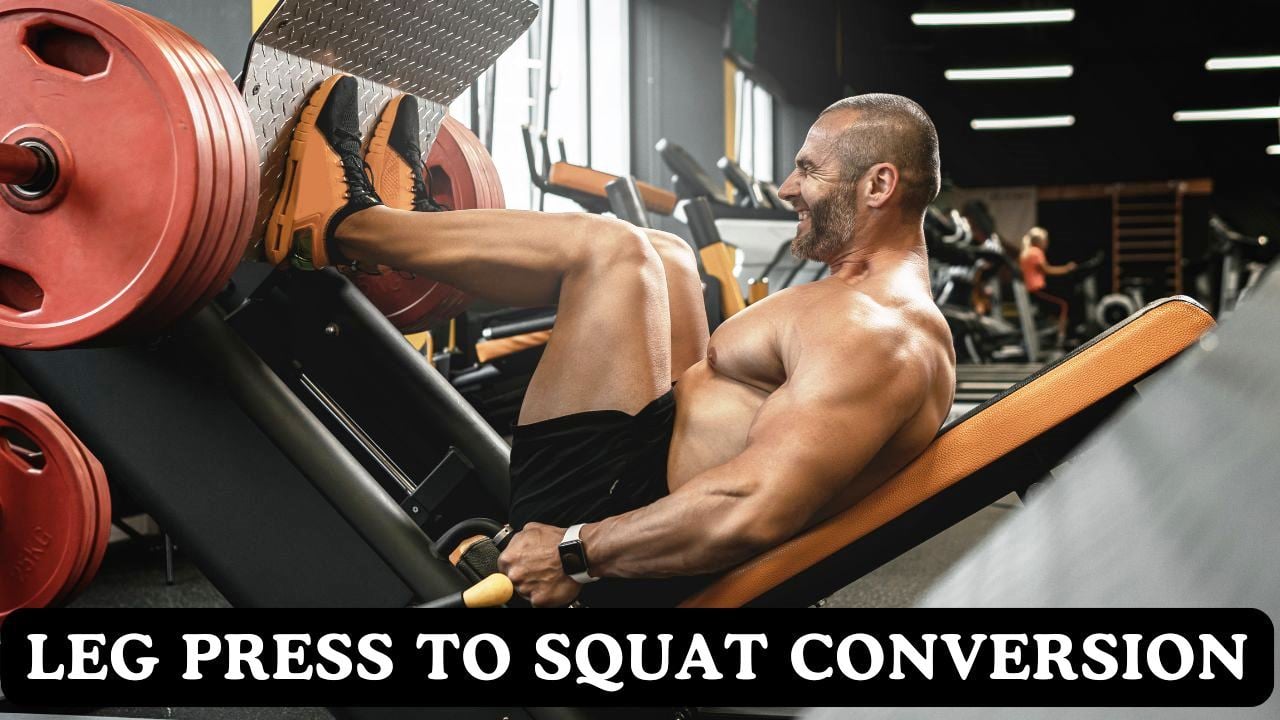Leg Press to Squat Calculator
Convert your leg press strength to squat equivalent and understand the biomechanical differences

Leg Press to Squat Conversion
The leg press typically allows you to handle 2-3.5 times more weight than squats due to several biomechanical factors. Research shows that the leg press machine provides external stability, eliminates spinal loading, and reduces the need for core stabilization and balance that squats require. The seated/reclined position and guided movement pattern significantly reduce exercise complexity, allowing for heavier loads with less technical skill. Understanding this difference helps you set realistic expectations when transitioning between exercises and planning your leg workout routine.
Biomechanical Factors
Several key factors contribute to the strength difference between leg press and squats. The leg press eliminates spinal loading, reduces range of motion requirements, and provides machine-guided stability. Studies demonstrate that squats require significantly more core activation, hip mobility, and ankle flexibility. The free-weight nature of squats also demands greater proprioception and balance, which naturally limits the load you can handle compared to the supported leg press position.
Training Applications
Use this conversion calculator to bridge your training between leg press and squat exercises effectively. If you’re strong on the leg press but struggle with squats, focus on mobility work and technique refinement. Conversely, if you excel at squats, you can estimate your leg press potential for setting training targets. This knowledge helps in creating balanced leg training programs that incorporate both exercises strategically for maximum strength and muscle development.
Conversion Ratios by Experience Level
| Experience Level | Typical Ratio | Range | Key Factors | Training Focus |
|---|---|---|---|---|
| Beginner | 3.0:1 | 2.8-3.5:1 | Limited squat technique, mobility issues | Form development, flexibility |
| Intermediate | 2.5:1 | 2.3-2.8:1 | Developing technique, building strength | Progressive overload, consistency |
| Advanced | 2.2:1 | 2.0-2.4:1 | Refined technique, good mobility | Specialization, periodization |
| Elite | 2.0:1 | 1.8-2.2:1 | Optimal technique, sport-specific training | Competition prep, peak performance |
Note: These ratios are based on research data and practical observations from strength training populations. Individual variations exist due to anthropometry, training history, and biomechanical differences.
Machine Angle Impact on Strength
45° Leg Press (Most Common)
The 45-degree leg press is the most widely used variation, offering a balanced compromise between load capacity and muscle activation. This angle provides moderate resistance throughout the range of motion while maintaining joint-friendly mechanics. Research indicates that the 45° angle effectively targets quadriceps, glutes, and hamstrings with optimal force distribution. Most conversion ratios are based on this standard angle, making it the reference point for strength comparisons.
90° Vertical Leg Press
The vertical leg press places you directly under the weight, but actually allows for higher loads due to gravity assistance during the eccentric phase. This position typically increases load capacity by 10-15% compared to the 45° version while providing excellent quadriceps activation. The vertical angle requires greater core stability and can be more demanding on the lower back, making proper form crucial for safety and effectiveness.
Horizontal Leg Press
Horizontal leg press machines actually require more effort throughout the range of motion as you work against gravity consistently. This position typically reduces load capacity by 10-15% compared to 45° versions but provides better functional carryover to squats. The horizontal position eliminates gravity assistance and requires more consistent force production, making it more similar to free-weight squatting mechanics.
Muscle Activation Comparison
| Muscle Group | Leg Press Activation | Squat Activation | Difference | Training Implication |
|---|---|---|---|---|
| Quadriceps | High (85-90%) | Very High (90-95%) | Similar | Both excellent for quad development |
| Glutes | Moderate (60-70%) | High (80-90%) | Squats superior | Squats better for glute activation |
| Hamstrings | Low-Moderate (40-50%) | Moderate (60-70%) | Squats superior | Additional hamstring work needed with leg press |
| Core | Minimal (10-20%) | High (70-80%) | Squats much superior | Separate core training needed with leg press |
| Calves | Low (20-30%) | Moderate (40-50%) | Squats superior | Both require additional calf training |
Training Strategies and Applications
🎯 Strength Assessment and Goal Setting
Use leg press to squat conversions for realistic goal setting and progress tracking. If you can leg press 250kg, expecting a 100kg squat (2.5:1 ratio) is reasonable for intermediate lifters. This helps prevent unrealistic expectations and allows for proper periodization. Track both exercises separately while understanding their relationship for comprehensive lower body strength development.
📈 Progressive Overload Strategies
Implement both exercises strategically in your training program. Use leg press for high-volume, heavy loading phases when recovery is limited or technique needs refinement. Employ squats for functional strength, athletic performance, and comprehensive muscle activation. Consider alternating focus periods or using leg press as an accessory to squat-focused programs for optimal leg muscle development.
🔄 Exercise Transition Planning
When transitioning from leg press to squats, start with 60-70% of your calculated conversion weight to account for technique learning and stability requirements. Focus on mobility work, particularly ankle and hip flexibility, which are crucial for proper squat mechanics. Gradually increase load as technique improves, using the conversion calculator to track progress and set intermediate milestones.
Common Mistakes and Solutions
Overestimating Squat Capacity
Problem: Many lifters assume their squat should be higher based on leg
press numbers.
Solution: Use conservative conversion ratios (2.5-3.5:1 for beginners,
2.0-2.5:1 for advanced) and focus on technique development before load progression.
Remember that squat strength develops differently due to stability, mobility, and
coordination requirements. Start with bodyweight and
bodyweight leg exercises
to build foundational movement patterns before adding external load.
Neglecting Mobility Requirements
Problem: Focusing only on strength without addressing mobility
limitations.
Solution: Incorporate regular mobility work for ankles, hips, and thoracic
spine. Poor mobility artificially widens
the strength gap between leg press and squats. Use foam rolling
and dynamic stretching as part of your warm-up routine.
Biomechanical Factors Affecting Conversion
🧠 Neural Drive and Coordination
Squats require significantly more neural coordination than leg press due to multi-joint movement patterns and balance requirements. The central nervous system must coordinate multiple muscle groups simultaneously while maintaining postural stability. This increased neural demand limits the load that can be handled compared to the simplified leg press movement pattern, contributing to the 2-3.5x strength difference observed in research studies.
⚖️ Load Distribution and Spinal Loading
The leg press eliminates axial spinal loading by supporting the weight through the machine’s structure, while squats place the entire load on the spine and supporting musculature. This fundamental difference allows for significantly higher loads in leg press exercises. Additionally, the leg press distributes force through a larger contact area (back pad and seat), reducing pressure points and allowing for greater comfort with heavy weights.
Scientific Research and Validation
Biomechanical Analysis Studies
“A Comparison of Muscle Activation between a Smith Machine and Free Weight Bench
Press”
Journal of Strength and Conditioning Research –
This research demonstrates how machine-supported exercises allow for greater loads but with
different muscle activation patterns
compared to free-weight movements. The findings support the 2-3.5x strength difference
observed between leg press and squat exercises,
with machine exercises showing reduced stabilizer muscle activation but higher prime mover
loading capacity.
Muscle Activation and Load Capacity Research
“Lower Extremity Muscle Activation during Horizontal and Vertical Leg
Press”
NCBI Research Database –
Comprehensive analysis of muscle activation patterns and load capacities across different
leg press variations and their
relationship to squat performance. This research validates the conversion ratios used in
strength training applications,
showing that leg press allows 2.0-3.5x greater loads depending on training experience and
machine configuration.
Strength Standards and Realistic Expectations
| Body Weight (kg) | Beginner Squat | Expected Leg Press | Intermediate Squat | Expected Leg Press | Advanced Squat | Expected Leg Press |
|---|---|---|---|---|---|---|
| 60kg | 40kg | 120kg | 75kg | 190kg | 110kg | 240kg |
| 70kg | 50kg | 150kg | 90kg | 225kg | 130kg | 285kg |
| 80kg | 60kg | 180kg | 105kg | 260kg | 150kg | 330kg |
| 90kg | 70kg | 210kg | 120kg | 300kg | 170kg | 375kg |
| 100kg | 80kg | 240kg | 135kg | 340kg | 190kg | 420kg |
Note: These standards are based on powerlifting data and assume proper technique. Individual results vary based on training history, anthropometry, and mobility factors. Use these as general guidelines rather than absolute targets.
Related Training Tools and Resources
🏋️ Complementary Exercises
Enhance your leg training with complementary exercises that bridge the gap between leg press and squats. Leg workout machines like hack squats and Smith machine squats provide intermediate stability levels. Incorporate cable leg exercises for unilateral strength development and stability training.
📊 Progress Tracking
Monitor your progress in both exercises to identify strength imbalances and training adaptations. Use our calculator regularly to reassess your conversion ratios as your experience level advances. Consider tracking additional metrics like body composition changes and mobility improvements alongside strength gains for comprehensive progress assessment.
⚕️ Training Disclaimer
This leg press to squat calculator provides estimates based on biomechanical research and training observations. Individual results may vary significantly due to factors including anthropometry, training history, mobility limitations, and technique proficiency. Always prioritize proper form over load progression and consult with qualified fitness professionals when implementing new training programs. The calculations are for educational and planning purposes only and should not replace individualized coaching or professional assessment. Start conservatively and progress gradually when transitioning between exercises.

Manish is a NASM-certified fitness and nutrition coach with over 10 years of experience in weight lifting and fat loss fitness coaching. He specializes in gym-based training and has a lot of knowledge about exercise, lifting technique, biomechanics, and more.
Through “Fit Life Regime,” he generously shares the insights he’s gained over a decade in the field. His goal is to equip others with the knowledge to start their own fitness journey.
